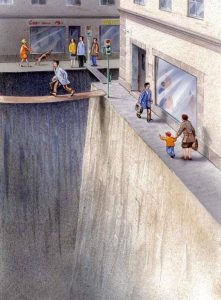Get your local on: last chance, Wellington!
All our towns are being shaped his year by a boring sounding but extremely important document: their Long Term Plan. It’s really important to have your say on the last one still open – it’s even worth missing a few minutes of MAFS.
Local government…
…
… …
Long Term Plan…
…
….
…. …. ….
Sorry I just nodded off there.
No jokes though, your local council’s long term plan or LTP has a big impact on your daily life so it’s absolutely worth 20 minutes. And yes, even worth missing a few minutes of your most favourite TV.
Why, though?
Councils do a huge variety of of things we need (with a very small proportion of the public money because our funding system is quite broken).
They do most of the things you experience everyday, so have a big influence on your quality of life.
![By Matthew Bowden www.digitallyrefreshing.com (http://www.sxc.hu/photo/158242) [Attribution], via Wikimedia Commons](https://talkwellington.org.nz/wp-content/uploads/2018/04/Tap--300x225.jpg)
Good to drink? A local government job
- Flushing the loo, putting out your rubbish, hearing rainfall (and not having to worry about what happens next)
- Using a local library, swimming pool, park
- Using the local roads and footpaths
- Living in a place you know your neighbours
- Being able to swim at the beach without worrying about poo
- People doing stuff on their place without bad side effects on you
- Turning the tap on and getting good water
Long term plans say what effort and resources are going to what, why, over the coming decade. That’s capital spending (building physical stuff, maintaining it) and operational spending (running stuff, providing services).
As the helpful Localcouncils.govt.nz say:
If there’s no money or proper priority put to something in your council’s LTP, good luck getting it.
And once set, they’re only reviewed once every three years.
Now is good. Actually, now’s essential
The new government is doing some stuff that will have a big impact on local councils.
One is changing the proportions of transport funding – this is a biggie. Much of what councils spend for your transport comes from taxes – the middle boxes here – as well as from rates (“local share”).
For our towns to have a good chance of getting their chunk of the available tax money, councils need to make sure that how they’re spending locally lines up with the government’s directions.
New government means new directions: the new administration has shifted the balance of tax spending on transport, using their Government Policy Statement on Land Transport and other bits of policy.
That’s got some real opportunities for our towns as destinations – as good places worth being in when you arrive.
This means a lot for our towns.
Big implications for us in the Wellington region are:

Your town’s streets could feel less like this.
- less crashable state highways (e.g. SH58)
- more scope for lower speed limits where people are asking for them (e.g. outside schools and kindies)
- more funding to make public transport better, and
- more money for movement by people – that’s local movement, by walking, bussing, training, biking, scooting, wheeling – versus money for making car travel happy (i.e. flash new motorways)
Now this is a key point: whether you like the coalition government or not, they’re not going anywhere for three years, and nor is that funding arrangement.
What else is set in place for three years? Your local long term plan!
And it’s also the main tool council has to get your town some of the central government money.
Opportunity’s knocking – tell your council to answer the door
With your few minutes, you can tell council to take this opportunity to improve the streets and community you live in and move in everyday – at less cost to the ratepayer.
“Do they really need telling?” you ask. “It sounds pretty sensible – wouldn’t they do it anyway?”
Yeah, nah.
You’d be really lucky if that was so.
Your LTP is unlikely to be progressive enough to take advantage of this new money arrangement because:

Odds are your town’s plan isn’t really fit for 2018-2021
- they were prepared last year (and many people thought the previous government would continue, with its transport spending dominated by new highway projects)
- the changes are quite significant and take a bit of adjustment (e.g. footpath maintenance schedules)
- status quo bias is endemic in organisations – i.e. it’s really hard not to do more same-same, because we’re used to it
- leadership is a bit too rare in local government when it comes to transport. (One common reason: councillors worrying disproportionately much about vocal constituents losing their marbles over their proverbial cheese being moved.)
So your streets and your community need your voice!
Submissions aren’t votes, but councillors need to get a clear vibe from the locals to feel confident doing good things (and anything a bit different).
Submissions periods are guaranteed to have plenty of people snarling about rates increases (because that’s what people do, especially those who have free time during the day) and generally throwing shade.
So help your councillors see that there are local people out there who’re backing them to be progressive – to spend locals’ money wisely, and position your town to get more of it from central government.

Top Tips… Tip Top!
Top Tips: the bluffer’s guide to a (quick) useful LTP submission
Generally councils’ communications teams are making some quite pretty consultation documents these days. Lots of nice images of happy local people and landmarks.
So do check out the consultation document first, to see what they’re asking about particularly (see below for suggestions of what to support). All the region’s LTPs are linked below.

It’s alright mate, you can just copy and paste those two lines in and you’ve got a good submission.
If you’re already feeling a bit overwhelmed, or start to as you read on, you could just say:
“Great to see some stuff but you really need to double down on providing for people walking, cycling, scooting, and taking public transport. But it’s not enough.
Go hard in this LTP, aligning local spending with the new GPS and get some of that tax money for making our town better for people!”
But if you’re feeling intrigued, get into it…
- Do a keyword search and see what’s around important words.
- Look for words like “walking”, “pedestrians”, “bikeable”, ”cycling”, “accessible”, “disability” and “public transport”. Do they have any “more of this” language in them?
- Check the roading and infrastructure bits of the plan. Do they talk about local trips, or change in “mode share” ? (That’s wonk speak for proportions of trips made by different transport “modes” – i.e. what you move by (including foot)).
2. Go to the money bit at the back – capital spending (expenditure) and operating.
- What are the proportions of money going to for roads and streets? If they show proposed vs last year’s, look for any change in them. (you want to see council responding to the government’s available money). Look especially for spending that you can see would help locals’ walking, bussing, biking, wheelchairing, scooting.
- Look for spending that seems to be on traffic calming (every council should be intending to spend on this – especially places people have been concerned about speeding or dork driving).
3. Throughout…

Nice warm fuzzy stuff like “healthier communities” or “more active trips” *may* be alright in the front of your Long Term Plan but it needs specifics too
- Look for: targets. Words without numbers are no good. The front bit, the strategic bit of the plan, often gets written by planners or even comms folk – and may be just lovely words.
- Your council should get a tick for saying “healthier communities” and “great place experience” or “boosting active travel” but you want to see targets. They might not be as good as SMART objectives, but you want to see numbers, like “increase the proportion of local trips made by active modes or public transport to xx%”.
- And good ambitious numbers too – that’s what’ll get government money coming. Who knows – your council may even achieve some of these!
“Is that proposal a good idea?”
You’ll probably be asked whether you support or oppose some new initiatives.
We’d suggest you should be inclined to support
- any proposal that’s talking about enabling “good choices” for people’s daily trips – better bussing, cycling paths, better walking experience.
- (Top tip: There’s always value in writing in the “Comments” box that you want good “connectivity” – planners’ jargon for “humans can get easily from one thing to the other”. This helps avoid little islands of human-friendliness in your town that people can’t get between without driving.)
- any proposal for pedestrianising or reducing cars’ presence in your urban centre’s heart
(Yes, seriously. Fewer cars and slower traffic = nicer for people, and it’s you – people – who your town’s supposed to be for. Plus retailers worldwide overestimate how important parking is for commerce.)
- Proposals for “intensifying” or “higher density” residential and mixed land-uses around transport nodes (or “hubs” or similar language). This means, broadly, that useful stuff will be clustered where people need it. So people can pop to the shops, bus, train on foot (or on a mobility scooter) rather than having to drive or take lots of public transport to get things done. It should be done right but don’t let the great be the enemy of the good – all our towns need greater density.
Get your views heard
-
- Don’t worry that you have to write lots of stuff down. Just do quick answers to the questions – they don’t even have to be full sentences, just clear enough for the submission-collating person to understand.

There may be a cat in your oral presentation video; this is okay.
- Be open to making an oral submission! They make the most difference. Tick the box “speak in support of my submission” or “present in person”. You can always pull out if you lose your nerve, or if it becomes logistically impossible many councils accept short videos.
- 30 seconds with the wee video on your phone’s camera app can do the trick – you can just read out your key points off a paper, it needn’t look professional. Councillors will hear your message and get the vibe almost as well as if you were in the room.
Go get your local on!
The time is now, and this is probably the best few minutes’ investment in your town that you’ll make in three years! Definitely worth missing a bit of MAFS for.
All the region’s LTP submission periods have now closed except Wellington City.
Nose of the Fish
- Wellington City Council – LTP and submission form; get in by 15 May 5pm – that’s Monday!
West side:
- Kāpiti Coast District Council: LTP (a really L TP!) and submission form; get in by 23 April 5pm -CLOSED
- Porirua City Council – LTP and submission form; get in by 23 April 8pm – CLOSED
East side:
- South Wairarapa District Council – LTP and submission form; get in by 23 April 5pm -CLOSED
- Upper Hutt City Council – LTP and submission form; get in by 27 April 5pm CLOSED
- Lower Hutt City Council – LTP and submission form (yes, do register); get in by 3 May 5pm – CLOSED
Regionwide
- Greater Wellington Regional Council – overview, consultation document, submission form; get in by 29 April 5pm CLOSED
Can’t be bothered making a submission? Really sure?
Ok, just give your local councillor a quick call and write on their Facebook page.
(Hey, guess what! It’s no more effort to write that in the submission form… and instead of just one you can say it to several councillors at once! Go on…)
Image credits:
- Banner: We Live Here show
- Tap: by Matthew Bowden, via Wikimedia Commons
- Street chasm: painting by Karl Jilg
- Cat in the kitchen sink – by HydraCarina
- Tired dog – by Patricia McConnell


Leave a comment